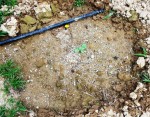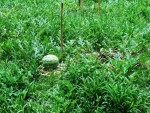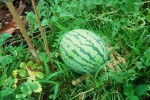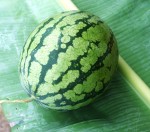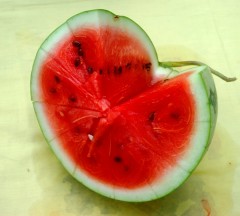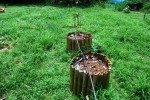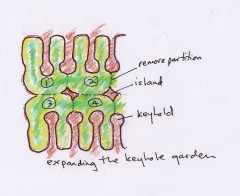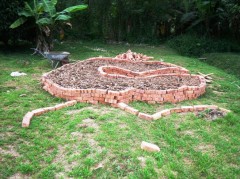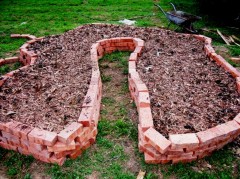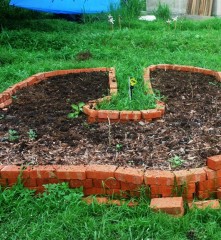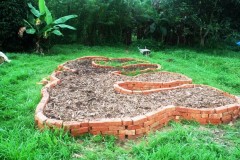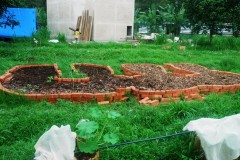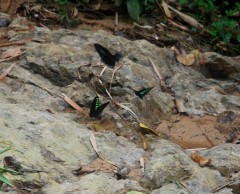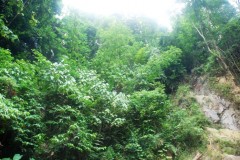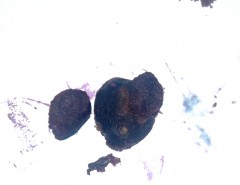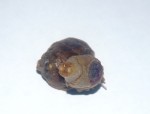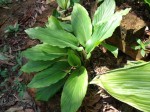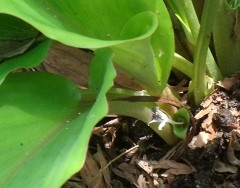Sep 30, 2009
Organic Watermelons Anyone?
I love watermelons and just cannot find organic ones.
So we decided to grow our own.
Watermelons need sandy soil and plenty of water.
Watermelons on the way.
Almost ready for harvest. So far, no loss to insects and disease due to our sprays of Teh Qi and herbs.
Our first watermelon
Beautiful color and juicy; shared by Alternative Mom and her family with us.
Next, watermelon on raised beds:
If successful, we will go commercial as the market have very little and inconsistent supply of organic watermelons.
18:12 Posted in Blog | Permalink | Comments (0) | Tags: watermelons, raised beds, organic watermelon
Sep 24, 2009
Expanding Keyhole Raised Beds
One of the biggest headaches in organic vegetable farming in Malaysia is weeds. The weeds just grow too fast; napia, as an extreme example can reach 5 feet in 30 days. And do not forget lalang! Some conventional farmers here lay the entire planting area with plastic sheeting. Heck, some commercial organic farms do the same!
Weeding is back-breaking work especially for those new retirees who dream of establishing an organic farm: your back is going to give up before your first harvest.
Raised bed is one answer. For the new farmer, you can use an expandable raised bed design that we have developed to suit our local conditions and needs:
1. To increase your production capacity as your sales increases.
2. To reduce labour costs
3. To reduce weeding costs
4. To reduce dependence on machinery
5. To ensure long term soil fertility
6. To eliminate digging and tilling of the soil
Soil fertility has not been a problem with us using raised beds. Earthworm population remains high. And replanting by crop rotation and continuous adding of compost into the raised beds keeps production at optimum levels harvest after harvest.
This is the expandable raised bed design developed by us based on designs developed by permaculturists. The keyhole and curved edging allows for maximum utilisation of space, and it looks good compared to straight rows of beds.
(Click for close-up):
Bed One
Close up of bed One. You can reach half of the bed from within the keyhole and the other half from the outside edge of the raised bed.
How about that? After one month, still no weeds (well, if you can call those few pathetic sprouts, weeds). Notice how the top layer has changed to a darker color over the month. This is indicative of earthworm activity.
Adding Bed Two after one month
It is preferable to use stones or discarded bricks and concrete blocks to make your raised bed walls ( I make it a habit nowadays to stop at demolition and construction sites to pick up old bricks, etc). It is a one-time investment in labour and costs, and lasts forever as opposed to bamboo, timber, etc. Remember that in Malaysia, labour costs are a large component of your production cost and you do not want to incur labour costs repeatedly for the same thing.
(Click for close-up)
Another view: Beds One and Two, expanding laterally.
Now that we have demonstrated that even after 30 days there is no weed problems, we have started sowing Bed One with 3 different varieties of vegetables and in Bed Two, a wild amaranth (bayam pasir), a personal favourite. Go for heritage seeds when you first start out. They will do very well on compost and raised beds, have less disease and insect problems and will be very forgiving of your mistakes.
20:28 Posted in Permaculture | Permalink | Comments (2) | Tags: keyhole beds, raised beds, organic vegetables, no-dig garden, permaculture
Sep 14, 2009
Amongst the Raja Brooke's Birdwings
Did two hours of taichi and qi gong at this small cascading stream near the farm yesterday. The place was deserted.
Click on pictures to enlarge
A group of about ten Raja Brooke's Birdwings came to join me, fluttering around me with no fear.
And a pair of pretty yellow-green butterflies.
It doesn't get much better than this.
This morning my BP was 115 / 68; like new. And that crick in the knee was gone.
Have to make it a habit to do the exercises here, each week; amongst the Raja Brooke's Birdwings
20:51 Posted in Blog | Permalink | Comments (0) | Tags: raja brooke's, birdwing butterflies, qi gong, tai chi
Sep 09, 2009
Black Curcuma / Black Turmeric
We have this very delicate small curcuma (barely a foot tall) that produces a completely black rhizome.
It is clearly not temu hitam or curcuma aeruginosa roxb. The temu hitam plant is larger, more robust and the rhizome is only slightly bluish. The leaves of the temu hitam have a purplish spine and the flower is reddish, pinkish.
Click for close up
The completely black / deep purple rhizome.
Click for close up
The rhizome before removing the thin skin.
It does not seem to be curcuma caesia or Kali Haldi (click on word for wiki article) which looks like curcuma aeruginosa.
Click for close-up
Anybody knows the scientific name for this curcuma? I have not been able to find any reference to it.
NOTE 22/7/2012 : TWO READERS OF THIS BLOG, ONE FROM HAWAII, AND ANOTHER FROM LANGKAWI, PAK DIN, http://herbwalk-langkawi.com.my/thewalk.html HAVE IDENTIFIED THIS PLANT AS Kaempferia parviflora, A PLANT FOUND IN NORTHERN THAILAND AND USED EXTENSIVELY FOR TRADITIONAL MEDICINE. THANKS TO BOTH FOR HELPING OUT.
THE PLANT WAS FOUND IN A FOREST NEXT TO OUR FARM. WE TAKE NOTE THAT THE FOREST IN QUESTION IS BOUNDED ON THREE SIDES BY FARMS AND ON ONE SIDE BY A FOREST RESERVE. WE CAN ONLY SPECULATE HOW IT WAS INTRODUCED INTO THE FOREST, THOUGH WE MUST ADMIT IT SEEMS EXTREMELY WELL ADAPTED TO THE CONDITIONS LOCALLY AND WE HAVE NEVER SEEN ANY DISEASE AFFECTING THE SAID PLANT.
15:18 Posted in Blog | Permalink | Comments (8) | Tags: black turmeric, kunyit hitam, temu hitam, kali haldi, curcuma aeruginosa, curcuma caesia








